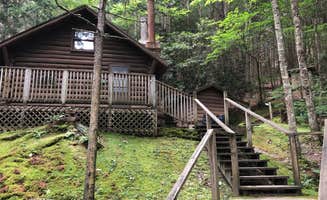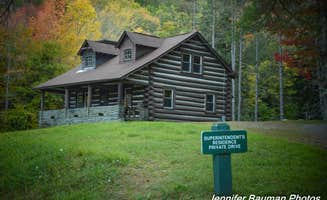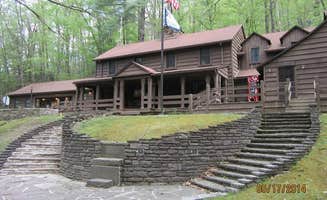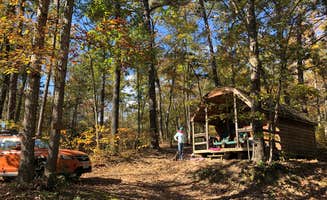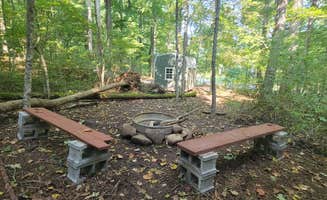The cabins near Cass, West Virginia range from primitive to modern accommodations at elevations between 2,300 and 3,500 feet throughout the Allegheny Mountains. Most cabin properties experience significant temperature fluctuations with summer days reaching the 80s and nights dropping to the 50s, while winter temperatures regularly fall below freezing. Late spring through early fall sees the heaviest visitation, with limited off-season availability at select locations.
What to do
Lakeside recreation: At Riverside Campground — Watoga State Park, cabin guests can access the Greenbrier River for water activities. "The Greenbrier River was right at the back of our site. People were floating and fishing and paddling," notes one visitor. The park also offers access to the 80-mile Greenbrier River Trail for biking and hiking.
Wildlife observation: Sites at Seneca State Forest provide excellent wildlife viewing opportunities from cabin porches. A camper reported, "Encountered 19 deer, 1 bear, and several other small creatures" during a short summer stay. Most wildlife sightings occur at dawn and dusk when animals are most active.
Historic exploration: Many cabin areas contain remnants of early 20th century industry. "Old and obviously precisely laid by man some time ago" rock walls can be found along Mill Creek in Holly River State Park, evidence of former settlements. A visitor explained, "There was actually a town down in there... we pulled coal from the ground," providing context for these historic remains.
What campers like
Remote settings: Kumbrabow State Forest Mill Creek Campground offers cabins in particularly secluded environments. "This campground in the Kumbrabow State forest has 13 campsites that are pretty secluded and private. They are all surrounded by woods and a river," reports one visitor. Most cabins have limited or no cellular service, providing true disconnection.
Creek sounds: Many cabins sit adjacent to mountain streams, providing natural sound therapy. One visitor at Holly River State Park Campground noted, "We enjoyed the beautiful drive in with the fall colors and the little stream next to the road that goes through the campground." Several sites feature porches or fire rings positioned specifically to take advantage of flowing water sounds.
Self-sufficiency experiences: Visitors appreciate the rustic nature of many cabins. A visitor at Kumbrabow observed, "Hard to access, need 4 wheel drive and GPS, good sense of direction." This remoteness appeals to those seeking an authentic mountain experience away from modern conveniences.
What you should know
Water access limitations: Many primitive cabins have no running water on-site. At Kumbrabow State Forest, "There are pit toilets and a pump for fresh spring water in the campground. Two-miles down the road, there's a bathhouse next to the Kumbrabow forest headquarters." Visitors should bring containers for transporting water from central pumps or spigots.
Limited connectivity: Cell service is minimal to non-existent at most cabin sites. A visitor to Watoga State Park noted, "It's in a valley, so there's no cell service. The wash houses have wi-fi, but it's not great and you have to be either in the building or sitting at the bench outside to use it." Emergency communications may require traveling to higher elevations or nearby towns.
Weather preparedness: Mountain cabins experience rapid weather changes. "It rained every day but two, on our month of camping," reported one camper at Holly River State Park. "I do recommend bringing additional tarps to cover any and everything you desire to stay remotely dry." Even summer months can bring significant precipitation and temperature swings.
Tips for camping with families
Kid-friendly water play: Cabins near gentle water features provide natural entertainment. At Camp Holly, "You can choose between hammock, tent, cabin or RV camping, I would recommend tenting it down by the beautiful rivers." A visitor mentioned the stream at Kumbrabow is perfect "to either fish or play in," making it suitable for supervised children.
Wildlife education opportunities: Multiple cabins offer chances to observe and learn about local animals. "Feed the ducks once they are your visitors for the weekend," suggests one Camp Holly visitor. Many properties provide information about local flora and fauna in cabin information binders.
Playground proximity: When selecting a cabin for families, consider proximity to developed play areas. One visitor to Holly River State Park cautioned, "Some campsites are by a playground, avoid those if you don't have kids yourself." Several parks maintain playground facilities within walking distance of select cabin units.
Tips from RVers
Tight access roads: Whittaker Campground near Cass offers cabins but requires careful navigation. "Great location for Cass RR or start or end of the greenbrier river rail trail. Privately owned. Grassy sites, 'mostly'," notes one visitor. Many forest roads leading to cabin areas have steep grades and tight turns unsuitable for towing large trailers.
Seasonal considerations: When transitioning between RV and cabin stays, water systems require attention. A Flatwoods KOA visitor cautioned, "Make sure you run the water lines to clear them out before hooking up. The water quality is very poor." Cabin water systems undergo similar seasonal challenges with spring runoff affecting water clarity.
Electricity limitations: Cabins with electricity typically provide limited amperage. "110/30 amp service at most sites," notes a Whittaker Campground visitor. Appliances requiring significant power may trip breakers, particularly when multiple devices run simultaneously. Many cabin kitchens utilize propane for cooking to reduce electrical demands.


